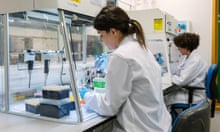Scientists believe they have discovered the mechanism for hair turning grey, which could help develop treatment to alter cells in order to reverse or halt the process.
A new study suggests stem cells may get stuck as hair ages and lose their ability to mature and maintain hair colour.
Certain stem cells – which are able to develop into many different cell types – have a unique ability to transition between growth compartments in follicles. These cells lose the ability to move with age, resulting in greyness.
The research focused on cells in the skin of mice and also found in humans called melanocyte stem cells, or McSCs.
The scientists, led by researchers from New York University Grossman school of medicine, suggested that if their findings hold true for humans they could open up a potential way to reverse or prevent grey hair.
The study’s lead investigator, Qi Sun, a postdoctoral fellow at NYU Langone Health, said: “The newfound mechanisms raise the possibility that the same fixed-positioning of melanocyte stem cells may exist in humans.
“If so, it presents a potential pathway for reversing or preventing the greying of human hair by helping jammed cells to move again between developing hair follicle compartments.”
Hair colour is controlled by whether continually multiplying pools of McSCs within hair follicles get the signal to become mature cells that make the protein pigments responsible for colour.
Researchers found that during normal hair growth the cells continually pivot between compartments of the developing hair follicle. It is inside these compartments where McSCs are exposed to signals that influence maturity.
Researchers found that McSCs transform between their most primitive stem cell state and the next stage of their maturation depending on their location.
According to the findings, as hair ages, sheds, and then repeatedly grows back, increasing numbers of McSCs get stuck in the stem cell compartment called the hair follicle bulge, where they remain.
A senior investigator on the study, Mayumi Ito, said: “It is the loss of chameleon-like function in melanocyte stem cells that may be responsible for greying and loss of hair colour.”










